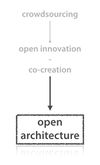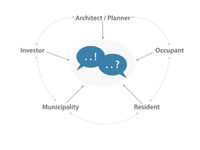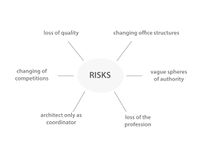OpenArchitecture
Open Architecture describes the opening of the creative designing- and planning-process in architecture. It refers to OpenInnovation, which is the term for opening innovation processes to a crowd to improve the development of products.
Contents
Meaning

- imbalance of crowd - planners
- creativity of the ordinary is often underestimated
- people are the ones who use buildings
- democratization of architecture
Figures
- planners
- investor
- administration
- crowd -> creative input
- there needs to be a clear border between design and detail (architects are still professionals)
Effect
Due to the newness of the architecture discipline in OpenInnovation there are different views on the risks and potentials of this process in the future.
Risks
A multitude of architects fear that the opening of the designing process will have a bad influence on the quality of the results. Furthermore the profession if the architect could be limited on the role of the simple coordinator. Indeed the architect is the linking position between the investor, planner and the occupant but the essential part of the design is also in the hands of the processing architecture firm. Another point is the changing of the conventional structures in architecture offices. In other branches of profession, like fashion oder design, where Co-Creating is a fix part of the daily working life, the percentage of permanent employees drops permanently. A development to more and more freelancing and the so called Microtasking is obvious. This structure is no threat for designers but rather a positive aspect for the open innovation precess. But for major projects in arhcitecture it needs a fixed team of people who know how to communicate with each other.
Potentials
If the process of Open Architecture is regarded from another side, there turn up some potentials. First of all, the creative design-process can be improved with a lot more working heads. A multitude of ideas and wishes can be collected in this way. And even if the crowd is not involved in the designing process directly, so an interview with the people can be a good input at the start of any project. If that is the case, then the chance for the occupants to accept the result and to be happy about it is much higher as if they are presented with a fait accompli. If architects and investors involve the people into the process of planning and the city development there will form a closer connection between the city and the inhabitants. So, this could form a society of people who can identify with each other and the environment they live in. Furthermore the principle of Open Innovation applied in architecture can form a global network of professionals and other people who are interested for the exchange of knowledge. This is also a great chance for young people to get acces to knowledge and to connect with other people in this field.
Platforms
- is an online, open-source community dedicated to improving living conditions through innovative and sustainable design. It is the brainchild of Architecture for Humanity and the designers who volunteer with us, and through our local chapters. The platform is open to everyone and it enables the user to upload ideas, designs and plans. These can be seen and reviewed by anyone. In this way, it opens up a worldwide discourse about sustainability and makes the exchange of knowledge easier.
- The aim of Innosite is to create and further develop an active innovation environment within the construction industry in Denmark and to promote dialogue across professions and industries. The platform is open for players within and outside the construction industry, allowing property developers and companies to invite tenders for development assignments, share ideas and provide inspiration for new innovation methods.
- is a platform, where clients can post projects of (landscape-) architecture, interior design and art. A worldwide community of creatives has acces to these projects and anyone can take part in the competiton. So, the platform serves fot the connection of client and creative. Most projects are just small and exclusively creative tasks, so the intention of the founders is to support creativity aside from the individual profession.
Projects
- This was a project of the supermarket firm Spar in South Tyrol.
Discussion
DIALOG IN DER ARCHITEKTUR ZWISCHEN BAUHERR, ARCHITEKT UND NUTZER ALS OFFENER PROZESS. TENDENZ: KONSUMER WIRD AUCH ZUM PRODUZENT. DER PROSUMER ENTSTEHT ALS HYBRIDGESTALT, DIE MITGESTALTET WAS SIE KONSUMIERT.
OPEN ARCHITECTURE IST EIN STETIGER PROZESS. DA ER OFFEN IST, SCHEINT ES SCHWIERIG EINE DEFINITION ZU TREFFEN, DA SIE IN SELBEN MOMENT WIEDER VERALTET SEIN KÖNNTE. WANN IST OPEN ARCHITECTURE SINNVOLL? IST OPEN ARCHITECTURE EINE LÖSUNG FÜR EIN VORHANDES PROBLEM?
WELCHE BEREICHE INNERHALB DER ARCHITEKTUR, MACHEN UNTER DEM BEGRIFF DER OPENNESS ÜBERHAUPT SINN? OPENNESS IST EIN ANDERE BEGRIFF FÜR NEUE ARBEITSTEiLUNG. WIE WIRD NEU AUFGETEILT? OPENNESS MEINT EINE BEREITSTELLUNG VON (MEHR-)WISSEN, WAS ZU EINE GRÖSSEREN WERTSCHÖPFUNG FÜHREN SOLL.
BAUHERR ALS INITIATOR, DER DAS BUDGET UND DAS HONORAR FESTLEGT, SOMIT GIBT ES OHNE BAUHERR UND KONKRETE BAUAUFGABE AUCH KEINE WERTSCHÖPFUNG. EIN WERTSCHÖPFUNGSPROZESS IST KOMPLEX UND INTERDISZIPLINÄR. KOMMUNIKATION ZWISCHEN DEN DISZIPLINEN IST SEHR WICHTIG. KOMPLEXITÄT VERLANGT ZERLEGUNG DES FACHWISSENS IN BEREICHE. STARK GESTEUERTE PROZESSE, DURCHGEFÜHRT VON FACHPLANERN UND EXPERTEN.
OPENNESS SETZT VORAUS: ELEMINIERUNG VON KOMMUNIKATIONSPROBLEMEN. DISKREPANZ ZWISCHEN VERBALER UND PLANSPRACHE. ENTSTEHENDE TRANSAKTIONSKOSTEN DURCH DIE VERMITTLUNG VON INHALTEN ENTLANG DER SCHNITTSTELLE DIESER BEIDEN KOMMUNIKATIONSSYSTEMEN. TRANSAKTIONSKOSTEN ENTSTEHEN.
Literature
- Steinbusch M., Walcher D. (Hrsg.), Open Architecture - Wie Partizipationsgesellschaft und technologischer Wandel die Architektur der Zukunft verändern werden, Dresden, Lulu Press, 2013, ISBN 978-1-291-25718-2





